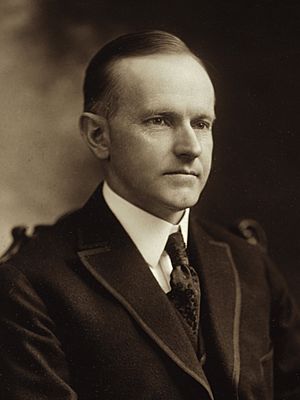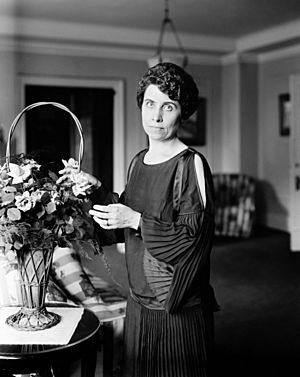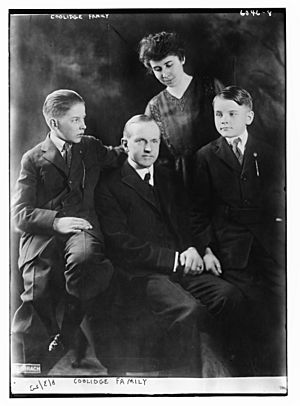Calvin Coolidge facts for kids
Quick facts for kids
Calvin Coolidge
|
|
|---|---|

Coolidge in 1919
|
|
| 30th President of the United States | |
| In office August 2, 1923 – March 4, 1929 |
|
| Vice President |
|
| Preceded by | Warren G. Harding |
| Succeeded by | Herbert Hoover |
| 29th Vice President of the United States | |
| In office March 4, 1921 – August 2, 1923 |
|
| President | Warren G. Harding |
| Preceded by | Thomas R. Marshall |
| Succeeded by | Charles G. Dawes |
| 48th Governor of Massachusetts | |
| In office January 2, 1919 – January 6, 1921 |
|
| Lieutenant | Channing H. Cox |
| Preceded by | Samuel W. McCall |
| Succeeded by | Channing H. Cox |
| 46th Lieutenant Governor of Massachusetts | |
| In office January 6, 1916 – January 2, 1919 |
|
| Governor | Samuel W. McCall |
| Preceded by | Grafton D. Cushing |
| Succeeded by | Channing H. Cox |
| President of the Massachusetts Senate | |
| In office January 7, 1914 – January 6, 1915 |
|
| Preceded by | Levi H. Greenwood |
| Succeeded by | Henry Gordon Wells |
| Member of the Massachusetts Senate | |
| In office January 3, 1912 – January 6, 1915 |
|
| Preceded by | Allen T. Treadway |
| Succeeded by | John B. Hull |
| Constituency | Berkshire, Hampden, and Hampshire counties |
| 16th Mayor of Northampton | |
| In office January 3, 1910 – January 1, 1912 |
|
| Preceded by | James W. O'Brien |
| Succeeded by | William Feiker |
| Member of the Massachusetts House of Representatives from the 1st Hampshire district |
|
| In office January 2, 1907 – January 6, 1909 |
|
| Preceded by | Moses M. Bassett |
| Succeeded by | Charles A. Montgomery |
| Personal details | |
| Born |
John Calvin Coolidge Jr.
July 4, 1872 Plymouth Notch, Vermont, U.S. |
| Died | January 5, 1933 (aged 60) Northampton, Massachusetts, U.S. |
| Resting place | Plymouth Notch Cemetery |
| Political party | Republican |
| Spouse | |
| Children | 2, including John |
| Parent |
|
| Relatives |
|
| Education | Amherst College (AB) |
| Occupation |
|
| Signature |  |
Calvin Coolidge (born John Calvin Coolidge Jr.; July 4, 1872 – January 5, 1933) was an American lawyer and politician. He became the 30th president of the United States, serving from 1923 to 1929. He was known for being quiet, earning him the nickname "Silent Cal."
Contents
Who Was Calvin Coolidge?
Calvin Coolidge was born on July 4, 1872, in Plymouth Notch, Vermont. He is the only U.S. president born on this special holiday. His parents were John Calvin Coolidge Sr. and Victoria Josephine Moor. Although his birth name was John Calvin Coolidge Jr., everyone called him Calvin from a young age.
His father, John Sr., was a successful farmer and store owner. He also held many local government jobs. Calvin's mother passed away when he was 12 years old. His younger sister, Abigail, died when he was 18. His father remarried and lived to be 80.
Coolidge's Early Career and Family Life

Coolidge went to Amherst College where he was good at debating. After college, he moved to Northampton, Massachusetts, to become a lawyer. He learned by working with a local law firm. In 1897, he became a lawyer and opened his own office. He focused on business law and tried to solve problems outside of court.
In 1903, he met Grace Goodhue, a teacher at a school for the deaf. They married on October 4, 1905. They had two sons: John and Calvin Jr. Sadly, Calvin Jr. died at age 16 from an infection after getting a blister while playing tennis. This was a very sad time for President Coolidge.
Coolidge started his political journey in 1896 by helping a presidential candidate. He was elected to the Northampton City Council in 1898. He slowly moved up in Massachusetts politics, eventually becoming the state's 48th governor.
In 1919, when police officers in Boston went on strike, Governor Coolidge took strong action. He called in the National Guard to restore order. All the striking officers were fired, and new police were hired. This made him famous across the country as a decisive leader. Many Americans were worried about the spread of new ideas like communism at the time. Coolidge's actions showed he was tough on law and order.
The next year, Coolidge became the 29th vice president. He became president in 1923 after President Warren G. Harding suddenly passed away. In 1924, Coolidge was elected president on his own. He was known for believing in small-government and for his quiet personality.
Calvin Coolidge's Presidency
During his time as president, Coolidge helped people trust the White House again after some problems in the previous administration. He signed the Indian Citizenship Act in 1924, which gave all Native Americans U.S. citizenship. He also oversaw a time of fast economic growth called the "Roaring Twenties". He left office very popular. He believed in a hands-off approach to government and supported businesses.
Coolidge followed the ideas of his Secretary of the Treasury, Andrew Mellon, who thought that lowering taxes would actually help the government collect more money. Congress agreed, and taxes were reduced during Coolidge's term. He also wanted to cut government spending and reduce the national debt.
Congress passed tax cuts in 1924, 1926, and 1928. This meant that by 1927, only the wealthiest 2% of people paid federal income tax. Government spending stayed the same, and about a quarter of the national debt was paid off.
Coolidge faced criticism for how he handled the Great Mississippi Flood of 1927. This was a huge natural disaster. He sent his Secretary Herbert Hoover to help with relief efforts. However, some people felt Coolidge didn't show enough interest in federal flood control. He believed property owners should pay for much of the flood damage. When Congress passed a bill for flood control in 1928, Coolidge signed it privately.
Coolidge was against racial prejudice. He did not appoint any members of the Ku Klux Klan to government positions. During his presidency, the number of lynchings (illegal killings) of African Americans went down. Millions of people also left the Ku Klux Klan.
He spoke out for the civil rights of African Americans. He said their rights were "just as sacred as those of any other citizen." He also pushed for laws to make lynching a federal crime, but Congress did not pass these laws.
On June 2, 1924, Coolidge signed the Indian Citizenship Act, giving all Native Americans on reservations U.S. citizenship. On June 6, 1924, he gave a speech at Howard University, a historically black university. He praised African Americans for their progress in education and their contributions to the U.S.
In October 1924, Coolidge spoke about how important it was for Americans to accept differences. He thanked immigrants for helping to build the country. He said that while diversity caused problems in Europe, it was a "harmonious" benefit for the United States. He urged immigrants to avoid "race hatreds" and "prejudices."
Even though he was very popular and could have run for another term, Coolidge decided not to run in 1928. He felt that ten years as president would be "too long."
Life After the Presidency

After leaving the presidency in 1929, Calvin Coolidge moved to a large home in Northampton, Massachusetts. He enjoyed boating on the Connecticut River. He also served on a railroad commission and was involved with several organizations, including the American Foundation for the Blind.
Coolidge wrote his autobiography in 1929. He also wrote a newspaper column called "Calvin Coolidge Says" from 1930 to 1931.
In 1932, some Republicans wanted Coolidge to run for president again. But he made it clear he was not interested. He supported the current president, Herbert Hoover, who then lost the election to Franklin D. Roosevelt.
Coolidge's Death
Calvin Coolidge died suddenly on January 5, 1933, at his home in Northampton. He was 60 years old. He is buried in Plymouth Notch Cemetery in Vermont. His childhood home there is now a historic site.
Coolidge and New Technologies
Despite being known as "Silent Cal," Coolidge used the new technology of radio often. He held 520 press conferences, meeting with reporters more than any president before or since.
- His second inauguration was the first presidential inauguration broadcast on radio.
- On December 6, 1923, his speech to Congress was the first presidential radio address.
- Coolidge signed the Radio Act of 1927, which helped organize radio broadcasting.
- In 1924, he became the first president to appear in a sound film.
- When Charles Lindbergh returned from his famous flight in 1927, President Coolidge welcomed him. This event was also captured on film.
Interesting Facts About Calvin Coolidge
- He was the 30th president of the United States.
- His own father, John Calvin Coolidge, swore him into office.
- His nickname was "Silent Cal" because he didn't talk much.
- His wife, Grace, was a teacher at a school for the deaf. She helped raise awareness for deaf people and invited Helen Keller to the White House.
- He was famous for his strong stance during the 1919 Boston police strike. He said, "There is no right to strike against the public safety by anybody, anywhere, any time."
- For exercise, he rode a mechanical horse in the White House.
- He was the only president born on the 4th of July.
- In 1926, he was given a raccoon for Thanksgiving dinner. Being an animal lover, he decided to keep it as a pet named Rebecca. She was later given to a zoo in 1928.
- Coolidge was the only president to have his portrait on a coin while he was still alive.
Images for kids
-
Coolidge's home (1906−1930) in Northampton, Massachusetts
-
President Coolidge signing bills for veterans, June 5, 1924. General John J. Pershing is at left.
-
Coolidge with his vice president, Charles G. Dawes
-
Coolidge's cabinet in 1924, outside the White House.
-
Coolidge appointed Harlan F. Stone to the Supreme Court.
See also
 In Spanish: Calvin Coolidge para niños
In Spanish: Calvin Coolidge para niños

















